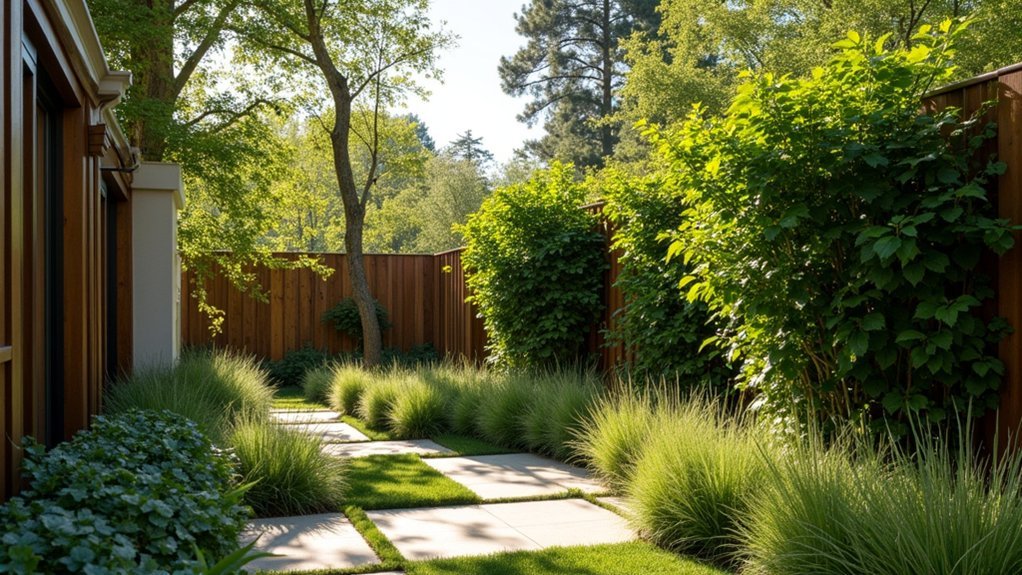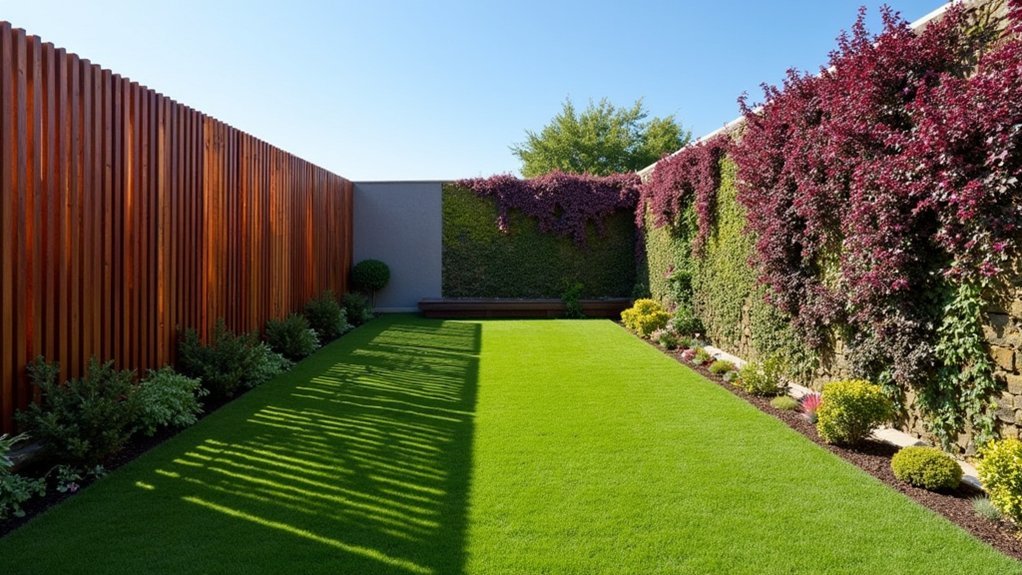For small properties, try these three smart windbreak designs: 1) Layered perimeter designs with mixed evergreens at different heights, 2) Compact corner windbreaks that target areas where wind accelerates, and 3) Living fence combinations using staggered plantings along boundaries. You’ll cut heating costs by up to 23% while creating wildlife habitat and preventing soil erosion. These space-efficient solutions blend functionality with aesthetic appeal for your limited landscape footprint.
Layered Perimeter Designs With Mixed Evergreens

While maximizing wind protection on a small property presents unique challenges, layered perimeter designs with mixed evergreens offer an elegant solution.
By strategically combining tall, medium, and low-growing Native Plants, you’ll create effective windbreaks that considerably reduce wind speed near your home.
Creating a natural gradient with varied native plant heights establishes powerful windbreaks that shield your living space.
Plant your evergreen trees in staggered rows at 2-5 times their mature height from structures for ideal wind protection. Species like Eastern Red Cedar and Colorado Blue Spruce work together to form a solid barrier that improves energy efficiency by reducing heating costs.
These layered designs don’t just block wind—they provide habitat for wildlife, enhance biodiversity, and prevent soil erosion.
For maximum effectiveness, incorporate lower-growing shrubs alongside taller specimens to create a continuous barrier from ground level upward, ensuring year-round protection while adding natural beauty to your landscape.
Compact Corner Windbreaks for Maximum Protection
When designing windbreaks for small properties, focusing on corners offers exceptional protection with minimal space requirements. By strategically placing dense evergreen trees and shrubs at property corners, you’ll greatly reduce wind speed where it naturally accelerates.
This smart design can cut heating costs by up to 23%, according to Texas A&M research.
For best results, position your corner windbreaks 2-5 times the mature tree height from your home. Select drought-resistant species like Eastern Red Cedar and Live Oak to guarantee longevity with minimal maintenance.
Creating multi-height plantings enhances both wind protection and aesthetic appeal while supporting local wildlife.
Your compact corner windbreak design doesn’t just block harsh winds—it creates energy savings, improves your landscape’s visual interest, and helps enhance biodiversity in your small outdoor space.
Living Fence Combinations for Small Lot Boundaries

Since limited space demands strategic solutions, living fences offer an ideal windbreak option for compact properties.
You’ll improve your home’s energy balance by strategically placing rows of trees or shrubs that block the wind, especially harsh winter winds. For effective landscape design, plant in staggered rows while maintaining at least 1 foot from property lines.
- Combine Eastern Red Cedar with dwarf shrubs for a dense, multi-layered barrier that maximizes wind protection
- Choose fast-growing options like Pittosporums that quickly establish protective coverage
- Include a mix of evergreens and ornamental grasses for year-round protection with visual interest
- Consider suitable plants with diverse growth habits to create natural-looking windbreaks that don’t overwhelm your space
This approach delivers privacy, wind protection, and aesthetic appeal—all critical elements for small property boundaries.
Frequently Asked Questions
How Long Until a New Windbreak Becomes Fully Effective?
Your windbreak won’t become fully effective immediately. It’ll take about 5-10 years for trees to mature enough to provide substantial protection, though you’ll notice some benefits within the first few years.
Can Windbreaks Negatively Affect Solar Panel Performance?
Yes, windbreaks can block sunlight if poorly positioned. You’ll need to carefully plan their height and location to avoid casting shadows on your solar panels, especially during peak production hours.
Which Windbreak Plants Are Safe Around Livestock and Pets?
For livestock and pet-safe windbreaks, you’ll want to choose non-toxic plants like arborvitae, junipers, and spruces. Avoid yew, oleander, and foxglove which are poisonous. Research specific plant toxicity for your particular animals.
How Do Windbreaks Impact Property Value and Insurance Costs?
You’ll find windbreaks can increase property value by enhancing aesthetics and reducing energy costs. They may lower insurance premiums by protecting structures from storm damage, though you’ll need to check with your specific provider.
What Maintenance Schedule Do Windbreaks Require During the First Years?
You’ll need to water your windbreak weekly in year one, monthly in year two, and during droughts thereafter. Prune annually, weed regularly, and replace any dead plants promptly during the first three years.
In Summary
You don’t need a large property to create effective windbreaks. Whether you choose layered perimeter designs with mixed evergreens, compact corner windbreaks that maximize protection, or living fence combinations along your boundaries, you’ll enjoy multiple benefits. These smart solutions not only shield your home from harsh winds but also increase privacy, reduce noise, and create habitat for wildlife—all while working within your space constraints.





Leave a Reply